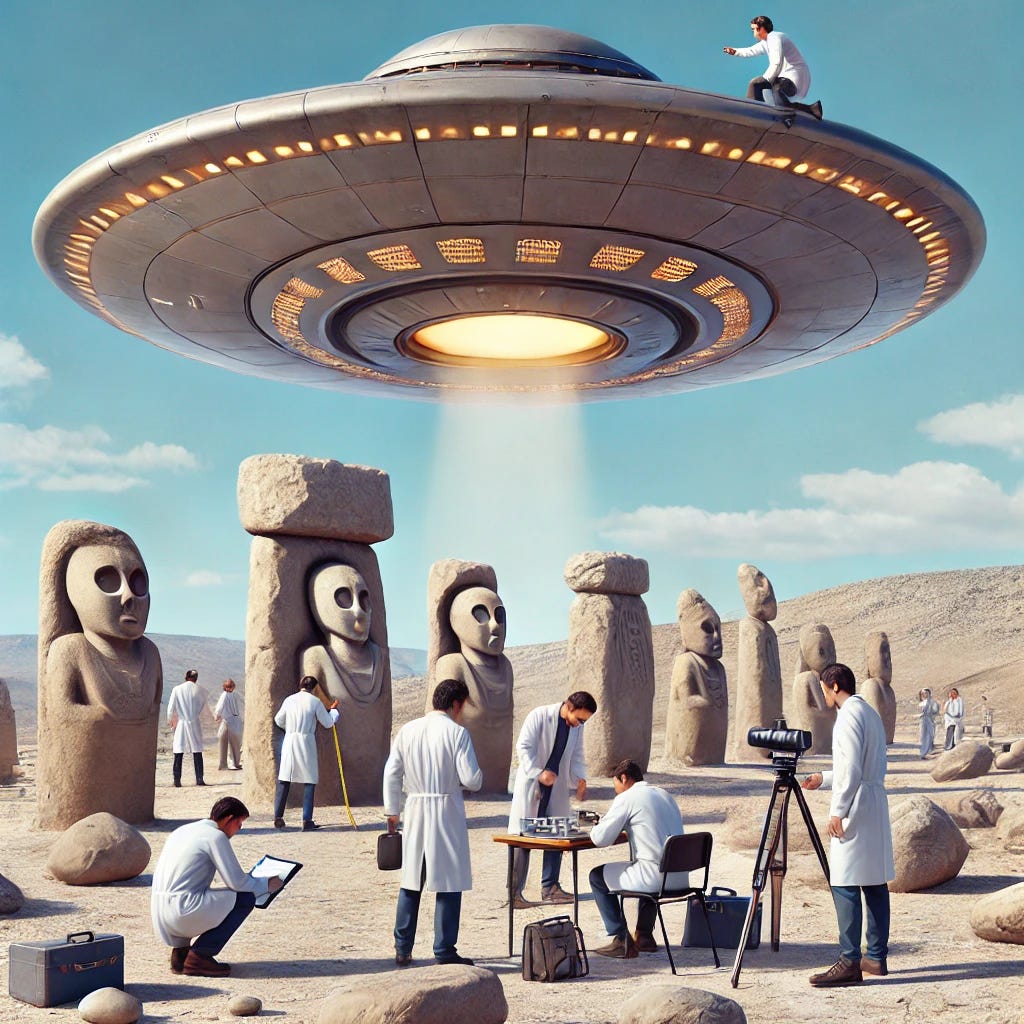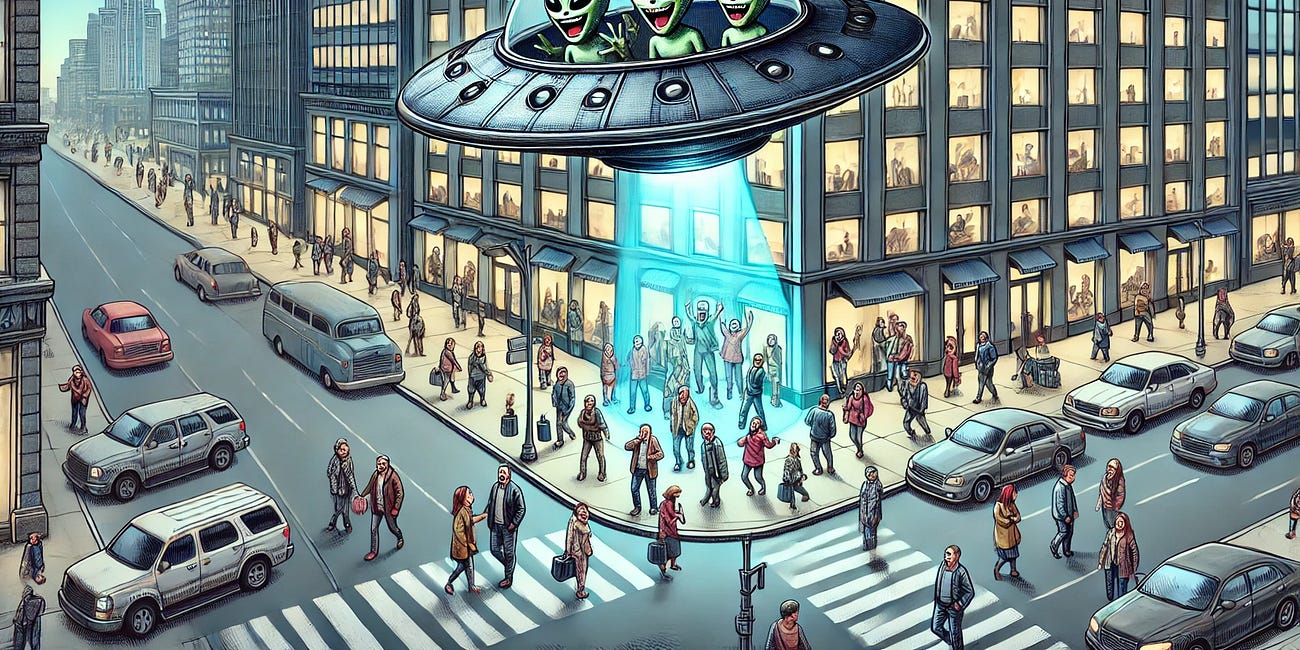Help! My Spaceship is Invisible! Part 2
Science tells us that things don't need to exist to be visible. But it helps!
This is the second part of a ridiculously long article about a paper about UFOs. I mean UAPs, as they're called now. I'm tempted to call them UAPFOs just to annoy the language police.
In part 1 of this article1, we discussed some claims about what it might mean if UAPs were treated as real. The authors of the paper2 thought it would mean that they must have some kind of bases or even cities here on Earth, probably very near UAP hot spots like nuclear weapons storage facilities and volcanoes.
I don't think I mentioned another thing the paper says, which is that UAPs might not be made and operated by space aliens at all. They might, instead, be the work of a hidden civilization of ancient humans. Maybe Neanderthals. That would be a neat explanation for why they went extinct. They didn't. They just went into hiding. Thus the wonderful term in the paper title: Cryptoterrestrials.
The paper continues to go through a laundry list of mildly interesting science, such as the 20th century discovery of Göbekli Tepe, a ruined and unusually ancient city. If the dating is correct, Göbekli Tepe is around 11,600 years old. That would make it the oldest known city.
That's even older than most of my jokes.
The reason for going through these discoveries in the paper is just to show that our knowledge is incomplete, which anyone with two or more brain cells already knew. It's almost as if they were trying to fill up space so it would be a paper rather than just a letter. They could have done it with a letter.
The ideas presented in the paper are kind of interesting, although anyone familiar with the field wouldn't find any of them to be new. That's my main criticism of the paper. It's not that they're covering a subject that a lot of people consider silly. It's just that they don't have anything very interesting to say about it. If they wanted to make it an actual scientific paper, they should have suggested strategies for finding these cryptoterrestrials.
Lesson for students: It takes more than speculation to make a SCIENTIFIC3 theory. A scientific theory needs to be something that can be tested by experimentation and the test needs to be repeatable. Also the results. If you get different results every time you do an experiment, there's probably something wrong with your theory. Or your experimental design. Or you might be an idiot. Never rule that possibility out!
BUT this paper (that should have been a letter) mentions another paper that I actually read when it first came out and that had some interesting ideas. It's called The Silurian Hypothesis: Would it be possible to detect an industrial civilization in the geological record?.
Here's the Abstract4.
If an industrial civilization had existed on Earth many millions of years prior to our own era, what traces would it have left and would they be detectable today? We summarize the likely geological fingerprint of the Anthropocene, and demonstrate that while clear, it will not differ greatly in many respects from other known events in the geological record. We then propose tests that could plausibly distinguish an industrial cause from an otherwise naturally occurring climate event.
Notice what they do here that's different. They don't just say, "Yeah. There's stuff we don't know so maybe there could have been people way back in dinosaur times or something and we wouldn't even know it!" They actually talk about what changes a hypothetical prehistoric civilization might have made to the Earth and whether or not we could detect those changes now. You won't be surprised to hear that they figure that the farther back in time a civilization existed, the harder it would be for us to find traces of it now. They even mention how long it would take for plate tectonics to erase whole cities from what we can find. Basically, if a civilization is a million years old, we might find some stuff. If it's a billion years old, we're completely out of luck. (See "plate tectonics.")
THIS is science. Take a potentially silly idea and see where it leads. NOT take a silly idea and then keep repeating, "It could happen!"
So! Could it happen? Could UAPs be artifacts of some civilization, maybe dating back millions of years, that's been hiding right here on Earth ever since?
The problem with UAPs being seen as real is that sometimes they do things that, according to what we know of the laws of physics, you can't do. For example, they've been seen making right angle5 turns while traveling at thousands of miles an hour. The laws of physics tell us this is a problem because of a thing called inertia, which is the tendency of things to keep going in the direction they're already going in.
Inertia is why you stop your car at a T intersection. If you tried to just take the turn without even slowing down, inertia would keep the car (and you!) going straight ahead even while the tires were trying to change the car's direction. The car would crash and so would you.
Even if a UFO could switch direction like that, at 2 or 3 or 12 thousand miles an hour, anything inside is going to go splat against the bulkhead. It would be a huge mess. If you want people to take anything about UAPs seriously, explain that before you go talking about where they come from. Or tell us how to find their bases and show us the vehicles and the people who fly them.
When Relativity was a new idea, almost everyone thought it was ridiculous. Einstein didn't say, "It could be. We don't know everything about light or gravity or time." He said, "Let's do some experiments and see if the theory holds water." Not in those exact words, of course. He mostly spoke German, which sounds entirely different. It's been more than a hundred years since Einstein proposed relativity, by the way. And people are still doing experiments to see if the results fit the predictions of his equations. For example, we have some recent evidence that relativistic time dilation is a real thing6!
I love these kinds of papers that talk about completely far out ideas like cryptoterrestrials. But I like the ones like the Silurian Hypothesis one that do some real science with it the best. I admire people who can use a slightly wacky idea like that as a springboard for actually interesting ideas. Maybe that's just me. What do you think?
Here's that prompt: "A flying saucer hovering over the ancient archaeological site of Göbekli Tepe, with its distinctive stone pillars and carvings visible. Several scientists in modern clothing are on the ground, using various instruments like cameras, measuring devices, and notepads to study the UFO. The scene is set in broad daylight with a clear blue sky, emphasizing the contrast between the ancient site and the futuristic spacecraft. The scientists appear focused and somewhat astonished as they conduct their measurements and observations."
I went ahead and did it. I started another substack. This one is entirely about history. I don't plan on making it as silly as Technoscreed but I'm completely incapable of writing without some humor. Check it out!
Help! My Spaceship is Invisible!
A few years ago, quite a bit before covid even, I read that the CDC had a disaster preparedness drill for a zombie apocalypse. At the time, there was a lot of laughter and some outrage over this frivolous use of taxpayer money but I actually approved. The zombie apocalypse they wer…
Sorry for the all-caps. If Substack had a better UI I would underline things but it's not that good.
The word "Abstract" is used in academic papers to describe what is actually a sort of summary of a paper. No one knows why it's called an abstract and not a summary.
If you've forgotten your grade school geometry, a right angle is what you get at a square corner. It's 90 degrees. Okay?
No, I'm not going to try to explain time dilation here. But you can hear a nice description of the research here:
I like Anton's videos. He explains things really well.





